|
|
|
Sort Order |
|
|
|
Items / Page
|
|
|
|
|
|
|
| Srl | Item |
| 1 |
ID:
171009
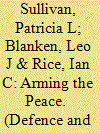

|
|
|
|
|
| Summary/Abstract |
What are the effects of foreign security assistance on the quality of the peace in post-conflict countries? Despite the stakes, and the tremendous amount of weaponry and other forms of foreign military aid flowing to governments of post-conflict countries, the academic literature provides little guidance as to what effects policymakers and practitioners should expect from this type of aid. Military assistance provided to the government of a country emerging from the turmoil of civil war could enable the state to establish a monopoly on the legitimate use of force, leading to a more durable peace and greater human security. However, we contend that significant flows of military aid and weapons from foreign governments may encourage regimes to adopt more repressive approaches to governance. We investigate the impact of security assistance on human rights conditions after 171 internal armed conflicts that ended between 1956 and 2012 using a novel measure of military aid and an instrumented measure of weapons transfers. We find strong evidence that both military aid and arms transfers to post-conflict governments increase state repression.
|
|
|
|
|
|
|
|
|
|
|
|
|
|
|
|
| 2 |
ID:
134029
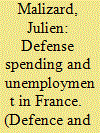

|
|
|
|
|
| Publication |
2014.
|
| Summary/Abstract |
France has received little attention in the literature of defense economics, despite some outstanding features of the country's situation. This study attempts to partially fill this gap with new empirical evidence which evaluates the influence of military expenditure on the unemployment rate between 1975 and 2008. Our estimation is based on the ARDL approach to cointegration. The results reveal that both defense and non-defense spending exert a negative influence on unemployment but that defense spending has a higher negative impact.
|
|
|
|
|
|
|
|
|
|
|
|
|
|
|
|
| 3 |
ID:
143599
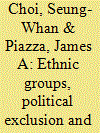

|
|
|
|
|
| Summary/Abstract |
This study examines whether the exclusion of ethnic groups from political power is an important contributing factor to domestic terrorism. To empirically test this question, we employ a negative binomial regression estimation on 130 countries during the period from 1981 to 2005. We find that countries in which certain ethnic populations are excluded from political power are significantly more likely to experience domestic terrorist attacks and to suffer from terrorist casualties; furthermore, ethnic group political exclusion is a more consistent and substantive predictor of domestic terrorist activity than general political repression or economic discrimination.
|
|
|
|
|
|
|
|
|
|
|
|
|
|
|
|
| 4 |
ID:
143600


|
|
|
|
|
| Summary/Abstract |
This paper analyzes time-sensitive data on a humanitarian crisis in the Middle East. It aims to assess the impact of the steep influx of Syrian refugees into Jordan on the country’s labor market since the onset of the conflict in Syria (March 2011). As of August 2014, nearly three million registered Syrians have sought refuge in neighboring countries (Lebanon, Jordan, Iraq, and Turkey), according to the United Nations High Commissioner for Refugees. Jordan and Lebanon are hosting the majority of them. This paper utilizes data regarding unemployment rates, employment rates, labor force participation, the number of refugees, and economic activity at the level of governorates. The vector autoregressive methodology is used to examine time series data from the most affected governorates in Jordan. The empirical results of Granger causality tests and impulse response functions show that there is no relationship between the influx of Syrian refugees and the Jordanian labor market. Our results are verified through a set of robustness checks.
|
|
|
|
|
|
|
|
|
|
|
|
|
|
|
|
| 5 |
ID:
134027
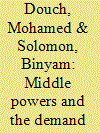

|
|
|
|
|
| Publication |
2014.
|
| Summary/Abstract |
This paper identifies and classifies middle power nations through the use of broad political science definitions, the demand for military expenditures models and gross domestic product (GDP) per capita. The latter is used as a simple quantifiable measure of relative and potential military power. The paper also develops and utilizes a threat variable that is applicable to middle power nations. The panel data analysis shows that the middle power nations react to threat variables that proxy global instability utilize foreign aid as a complementary policy tool along with military expenditures, and face significant trade-offs between military and non-military government spending.
|
|
|
|
|
|
|
|
|
|
|
|
|
|
|
|
| 6 |
ID:
134028
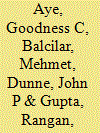

|
|
|
|
|
| Publication |
2014.
|
| Summary/Abstract |
This paper contributes to the growing literature on the milex-growth nexus, by providing a case study of South Africa and considering the possibility of structural breaks by applying newly developed econometric methods. Using full sample bootstrap Granger non-causality tests, no Granger causal link is found between military expenditure and GDP for 1951-2010, but parameter instability tests show the estimated VARs to be unstable. Using a bootstrap rolling window estimation procedure, however, finds evidence of bidirectional Granger causality in various subsamples. This implies standard Granger non-causality tests, which neither account for structural breaks nor time variation may be invalid.
|
|
|
|
|
|
|
|
|
|
|
|
|
|
|
|
| 7 |
ID:
139215
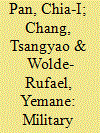

|
|
|
|
|
| Summary/Abstract |
This study revisits the causal relationship between military spending and economic growth in 10 Middle East countries via a panel causality analysis that accounts for cross-sectional dependence and heterogeneity across countries. Our results indicate unidirectional causality from military spending to growth for Turkey; one-way causality from economic growth to military spending for Egypt, Kuwait, Lebanon, and Syria; bidirectional causality for Israel; and no causality in either direction for Jordan, Oman, and Saudi Arabia. The empirical evidence does not provide consistent results regarding the causal relationship between defense expenditure and economic growth in these countries.
|
|
|
|
|
|
|
|
|
|
|
|
|
|
|
|
| 8 |
ID:
143602
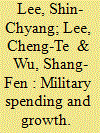

|
|
|
|
|
| Summary/Abstract |
The paper analyzes the effects of military spending on economic growth in a small open stochastic endogenous growth model involving the supply-side and demand-side effects produced by military spending. We show that a rise in the military spending affects economic growth through four channels, including the crowding-out effect, the spin-off effect, the resource mobilization effect, and the portfolio effect. The net effect which depends on these four channels is ambiguous. Hence, we demonstrate that there exists an optimal defense burden that maximizes the economic growth rate.
|
|
|
|
|
|
|
|
|
|
|
|
|
|
|
|
| 9 |
ID:
139216
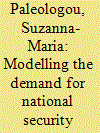

|
|
|
|
|
| Summary/Abstract |
In the past, national security for the majority of countries was almost exclusively associated with an external military threat emanating from a rival state(s). This was reflected in the standard models for the demand for military expenditure. The emergence of new security challenges such as terrorism, transnational crime networks, failed and rogue states, has profoundly affected the international security environment and the concept of national security. This note develops a model for the demand for national security expenditure adopting a broader, more inclusive definition of national security and includes concomitant budgetary outlets to meet the new security challenges.
|
|
|
|
|
|
|
|
|
|
|
|
|
|
|
|
| 10 |
ID:
171018
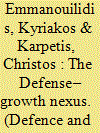

|
|
|
|
|
| Summary/Abstract |
A great part of the defense literature is focused on the interaction between military spending and economic activity. To investigate this interrelationship, researchers have applied a wide variety of methodologies with totally different assumptions and statistical properties. Until today, however, no detailed examination of the sensitivity of empirical results to the various statistical methods has been provided in the literature. The present paper attempts to fill this gap by providing, firstly, a review of the majority of the time series methodologies used in the defense–growth literature and, secondly, an econometric application using data of the U.S. economy over the period 1961–2015 in order to establish empirically the association between econometric procedures and empirical results. The empirical findings of the conducted analysis suggest that statistical methods can indeed become a significant source of variation in the investigation of the defense–growth nexus.
|
|
|
|
|
|
|
|
|
|
|
|
|
|
|
|
| 11 |
ID:
140828
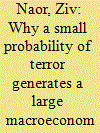

|
|
|
|
|
| Summary/Abstract |
It has been shown that terror activities have had a substantial macroeconomic impact. This work presents a macroeconomic model showing quantitatively that an increase in the probability of terror-induced death such as that observed in Israel in 2001–2004 is consistent with the documented contraction of economic activity associated with the impact of terror. The model includes fear of terrorism, represented as a higher level of probability perception than the cumulative-prospect theory expects, and a local government that can supply the public with a security good. The effectiveness of the production of the security good plays an important role in determining the terror-induced loss of production to the economy.
|
|
|
|
|
|
|
|
|
|
|
|
|
|
|
|
|
|
|
|
|